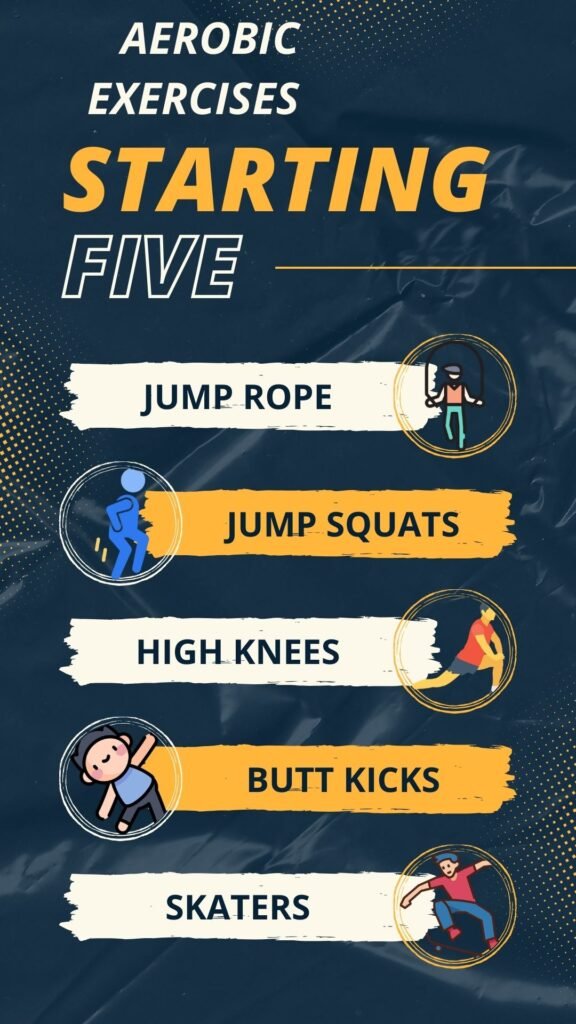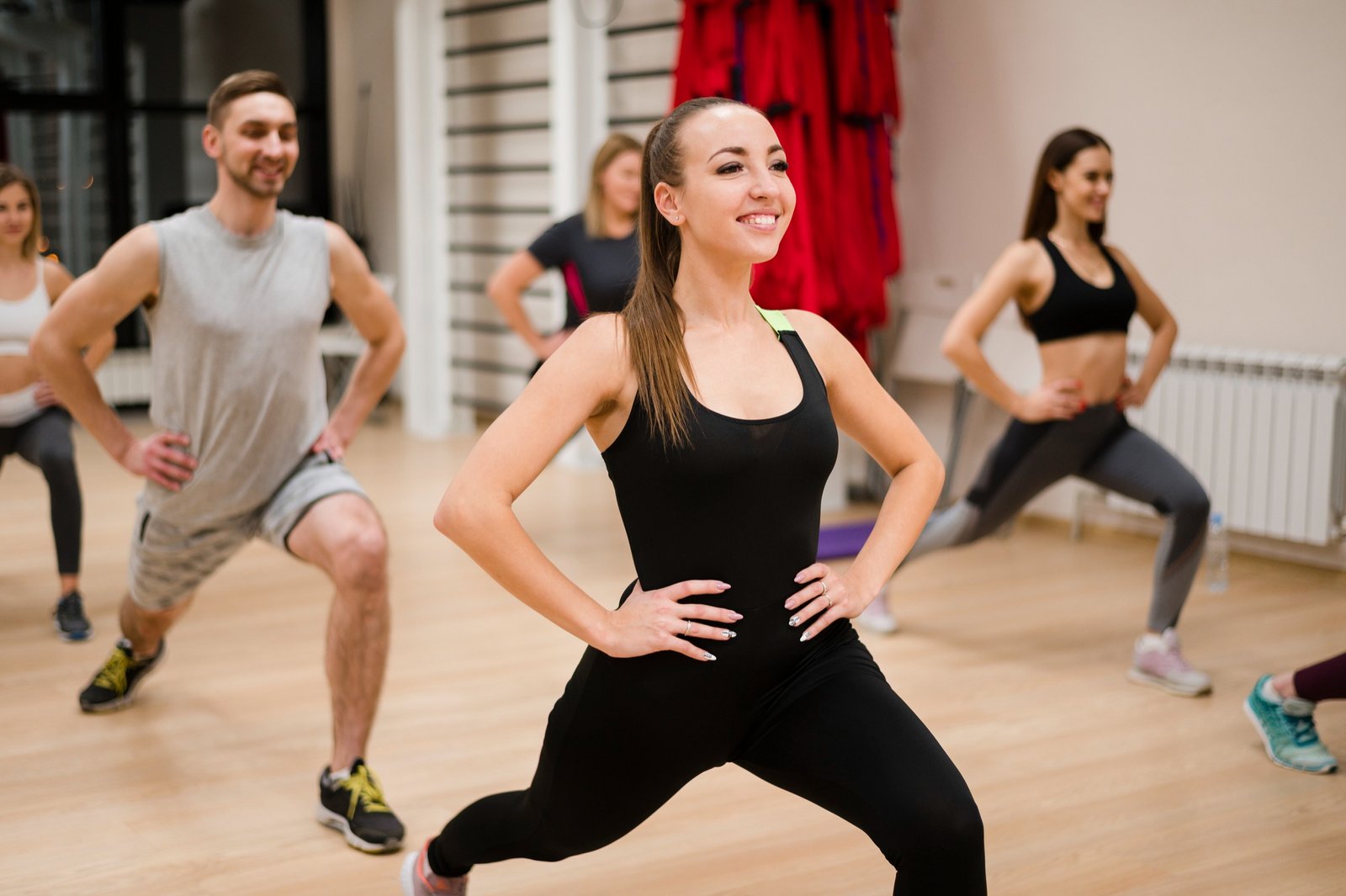What is aerobic exercise?
Aerobic exercise stands as a vibrant fitness regimen amalgamating dance elements with gymnastic motions, buoyed by rhythmic and motivating music.
Emerging from the USA during the 1980s, aerobics swiftly garnered popularity, enticing even the weariest of individuals into gymnasiums with its invigorating tunes and easily graspable routines. Sporting clubs, fitness studios, and adult education facilities now offer classes tailored to varying skill levels: novices find solace in low-impact aerobics, while step aerobics and high-impact aerobics cater to the adept. Notably, aerobics accommodates practitioners of all ages.
The essence of aerobic exercise lies in its capacity to ignite fat combustion and elevate metabolism, thus facilitating sustainable weight loss while concurrently serving as a stress mitigator.
The realm of aerobic exercise presents both boons and banes
Pleasure Quotient
Elevated spirits are fueled by music, bolstered by group camaraderie, and augmented by body positivity.
Fat Metabolism
Low-impact aerobics prioritizes fat oxidation in proportion to energy expended, whereas step aerobics and high-impact aerobics, though less inclined towards fat metabolism proportionally, burn more calories overall.
Cardiovascular Health
The brisk tempo of aerobics routines imposes significant cardiovascular demands, enhancing aerobic capacity and facilitating anaerobic adaptations. Tailored routines and music selection ensure optimal load management for practitioners of diverse proficiencies.
Spinal Health and Joint Protection
Mitigating joint and spinal impact necessitates a resilient floor and proper footwear, while pelvic alignment averts lower back strain.
To optimize aerobic exercise sessions
- Gradual warm-ups and cool-downs accompanied by stretching exercises are imperative to prevent inadvertent shifts into anaerobic territory, inhibit fat metabolism, and induce muscle acidity.
- Certified instructors and calibrated intensities warrant prudent selection to circumvent undue strain.
Persistent perspiration mandates adequate fluid intake post-exercise.
Endurance, coordination, and muscular fortitude undergo refinement through aerobics, albeit with limited emphasis on basic endurance.
However, caution is warranted.
- Only the low-impact variant is advisable for individuals with joint issues, obesity, hypertension, or cardiovascular ailments.
Minimal equipment, chiefly specialized aerobics shoes obtainable at fitness outlets, coupled with club or association memberships, suffices for participation.
Risk management is paramount.
- Vigorous jumps in aerobics pose potential strain on the ankle, knee, hip, and spinal joints, necessitating meticulous warm-up protocols to avert muscle strains, ligament tears, or joint discomfort.
Top 5 aerobic exercises

1. Jump rope
Maintain an upright posture with your feet near each other, lift your chest and head, and gaze straight ahead consistently. Draw your shoulders and elbows rearward, ensuring they remain steady. Utilize your wrists for rotating the rope rather than relying on your arms. Bounce on the midsoles of your feet, maintain a slight bend in your knees, and land gently.
2. Jump Squats
Maintain a straight back and keep your feet near each other. Draw your shoulders and elbows rearward, clasping your fists together in front of you. Keep your head lifted, gaze forward, and jump, spreading your legs to land in a squat stance. Ensure your knees form a right angle. Jump back up, returning to the initial stance.
3. High Knees
Maintain an upright posture with your feet slightly separated, shoulders pulled back, and arms hanging by your sides. Keep your head lifted and your gaze fixed forward. Lift your right knee as high as is comfortable while simultaneously swinging your left arm forward, mimicking the motion of running to generate momentum. Lower your knee gently, landing on the midsole of your foot, then swiftly switch to the opposite knee and arm. Repeat this sequence. High knees should resemble an exaggerated running motion.
4. Butt Kicks
Align your body in a straight posture and lean slightly forward. Ensure your feet are slightly separated, shoulders pulled back, and arms resting at your sides. Keep your head lifted with your gaze directed forward. While balancing on your right leg, lift your left heel toward your buttocks as much as comfortably possible, simultaneously swinging your right arm forward to create momentum akin to running. As you lower your foot, land softly on the midsole, then swiftly transition to the opposite heel and arm. Repeat this sequence. Butt kicks should resemble an exaggerated running motion, much like high knees.
5. Skaters
Position yourself with your feet slightly wider than shoulder-width apart, and allow your arms to hang naturally by your sides. Maintain a forward gaze as you spring onto your right foot, landing with a bent right knee and your left foot trailing behind your right. Simultaneously, swing your left arm forward and your right arm backward. Then, reverse the movement and repeat the sequence.
What is low aerobic exercise?
In the realm of fitness and wellness, aerobic exercise reigns supreme as a cornerstone of a healthy lifestyle. But what exactly is low-aerobic exercise, and how does it fit into your fitness routine? Let’s delve into this understated yet immensely beneficial form of physical activity.
Understanding Low Aerobic Exercise
Low aerobic exercise, also known as low-impact aerobic exercise, involves activities that elevate your heart rate and increase oxygen consumption, but with minimal stress on the joints. Unlike high-impact exercises like running or jumping, low aerobic exercises are gentler on the body, making them ideal for individuals with joint issues, seniors, beginners, or those recovering from injury.
Examples of low-aerobic exercises

1. Walking
Walking, a simple yet effective low-impact exercise, offers numerous health benefits without putting undue strain on the joints. Whether it’s a leisurely stroll in the park or brisk walking on a treadmill, this activity improves cardiovascular health, strengthens muscles, and boosts mood.
2. Swimming
Dive into a low-impact aerobic workout by hitting the pool. Swimming engages the entire body, providing an excellent cardiovascular workout while reducing the risk of injury. The water’s buoyancy supports the body, making it an ideal choice for individuals with arthritis or mobility issues.
3. Cycling
Whether outdoors or on a stationary bike, cycling offers a low-impact aerobic workout that targets the lower body muscles while improving cardiovascular health. Adjust the intensity to suit your fitness level, and enjoy a scenic ride or an invigorating indoor cycling class.
4. Elliptical Training
This machine mimics the motion of running without the impact, making it an excellent choice for those seeking a low-impact aerobic workout. Elliptical training targets multiple muscle groups while providing a challenging cardiovascular workout with minimal stress on the joints.
5. Yoga
While often associated with flexibility and relaxation, yoga can also be a form of low-aerobic exercise, especially in more dynamic styles like Vinyasa or Power Yoga. Flowing sequences and controlled movements elevate the heart rate and improve cardiovascular health while promoting strength, balance, and flexibility.
Read also: CARDIO WORKOUTS: ENERGIZE YOUR FITNESS ROUTINE
Aerobic exercise for belly fat: Harvard study
A recent study conducted by Harvard University suggests that dedicating just 20 minutes to exercise daily can effectively reduce belly fat in a healthy manner, without solely relying on crunches or sit-ups.
For individuals grappling with stubborn belly fat and seeking a sustainable solution, the findings of this Harvard study present a promising avenue worth exploring
Contrary to common belief, the study indicates that combating abdominal fat in the long term may not require arduous aerobic exercise like Nordic walking, jogging, cycling, or swimming. Instead, the research underscores the potency of strength training in addressing age-related belly fat accumulation.
According to the Harvard researchers
Men who engaged in 20 minutes of daily strength training exhibited a lesser increase in age-related abdominal fat compared to those who dedicated the same timeframe to aerobic exercises. However, the study suggests that the optimal approach may entail a combination of both strength training and aerobic activities.
Delving deeper into the findings
While men focusing solely on aerobic exercises experienced weight loss, their waistlines continued to expand. This phenomenon can be attributed to the muscle-building effect of strength training, which elevates the body’s overall calorie expenditure, consequently facilitating greater fat burning, particularly around the hips and abdomen.
The study, spearheaded by lead author Rania Mekary and her team at the Harvard School of Public Health, analyzed the physical activity levels, waist circumference, and body weight of over 10,500 healthy American men aged 40 and above. Spanning from 1996 to 2008, the Health Professionals Follow-up Study served as the platform for this investigation, with results initially published in 2014 and regularly updated thereafter.
Moreover, the study sheds light on the perilous implications of age-related belly fat, which encompasses heightened risks of cardiovascular ailments, diabetes, osteoporosis, and elevated blood pressure. Particularly worrisome is the presence of visceral abdominal fat, nestled beneath the abdominal muscles and encasing vital organs, which can precipitate severe health complications.
What is step aerobics?

Step aerobics embodies a fusion of traditional gymnastics and diverse dance elements, constituting a vibrant group fitness regimen led by an instructor.
Central to this workout are the rhythmic accompaniment of music, harmonizing movements, and guiding participants through the routines.
It comprises two main intensity levels: low-impact and high-impact. Low-impact routines involve stepping patterns where one foot maintains contact with the ground, whereas high-impact routines briefly lift both feet off the ground. However, it’s worth noting that purely high-impact workouts are not typically practiced.
Step aerobics sessions typically feature choreographed sequences learned gradually. There are notable parallels between step aerobics and other fitness classes such as Les Mills’ Body Pump, Body Balance, and Body Toning, as well as Zumba and Tae Bo.
What is the origin and evolution of step aerobics?
The roots of step aerobics trace back to the 1960s, when an American physician pioneered aerobic training, aiming not only to enhance endurance but also to fortify the lungs and heart. This initiative sparked a surge in the fitness industry, resulting in the development of numerous endurance and aerobic programs.
Shortly thereafter, step aerobics gained global recognition, thanks to fitness instructor Gin Miller for offering a joint-friendly exercise option.
What does a typical step aerobics session entail?
A standard session typically comprises four segments:
- Warm-up (preliminary warm-up and stretching)
- Cardio (fat burning and cardiovascular stimulation)
- Cooldown #1
- Cooldown #2 (stretching and relaxation)
Instructors guide participants through routines using verbal cues or synchronized gestures in tandem with the music.
Which muscle groups are engaged during step aerobics?
Primarily an endurance activity, step aerobics nonetheless targets various muscle groups, including the glutes, legs, back, and abdominal muscles.
Who can benefit from step aerobics?
If you enjoy exercising to music and mastering straightforward choreographies to engage your mind during workouts, step aerobics offers an ideal fitness option. Moreover, its adaptable intensity levels (low-impact and high-impact) render it suitable for individuals of all fitness levels.
How frequently and for what duration is step aerobics recommended?
Fitness experts advocate engaging in step aerobics three times per week for 30 to 60 minutes per session to optimize results. Consistency is key to achieving fitness goals.
What equipment is required for step aerobics?
Essential equipment includes sturdy, supportive footwear, given the dynamic and repetitive nature of movements. Most step aerobics classes provide non-slip stepper platforms. For home workouts using DVDs or online videos, a stepper is recommended.
How many calories can one burn with step aerobics?
On average, individuals can burn approximately 450 calories per hour of step aerobics, with fat burning typically initiating after 10 to 20 minutes. Caloric expenditure varies based on factors such as workout intensity.
Summary
“Aerobic Exercise: Energizing the Body and Mind for Optimal Health” explores the realm of aerobic exercise, its benefits, types, and recommendations for optimal results. Aerobic exercise, originating in the USA in the 1980s, combines dance elements with gymnastic motions and motivating music to engage participants of all skill levels and ages. It promotes fat combustion, metabolism elevation, stress reduction, and cardiovascular health.
Low-impact aerobic exercises, such as walking, swimming, cycling, elliptical training, and yoga, offer gentler alternatives suitable for individuals with joint issues, seniors, beginners, or those recovering from injury. A Harvard study suggests that dedicating just 20 minutes daily to strength training can effectively reduce belly fat, complementing aerobic exercises for comprehensive health benefits.
Step aerobics, a fusion of gymnastics and dance elements, provides a vibrant group fitness option suitable for various fitness levels. Originating in the 1960s and popularized by fitness instructor Gin Miller, step aerobics engages multiple muscle groups and offers adaptable intensity levels. A typical session includes warm-up, cardio, and cool-down segments, engaging primarily the glutes, legs, back, and abdominal muscles. It is recommended to do it three times a week for 30 to 60 minutes per session, burning approximately 450 calories per hour. Proper footwear and a stepper platform are essential pieces of equipment for step aerobics workouts.
